Earthbag house construction is an amazingly sustainable building method and has been a popular topic for years in the off grid community.
For those new to this concept, an earthbag is just as the name implies: a bag filled with earth. The bags are stacked to create buildings of various sizes and shapes quickly and relatively simply.
You’ve likely seen this concept used by the military in emergency situations, such as floods, to create unyielding protective barriers. The same idea is used in earthbag construction to erect homes worthy of withstanding natural disasters, extreme weather conditions, and even bullets.
The stacked bags are covered in plaster, giving earthbag homes a beautiful adobe appearance when complete.
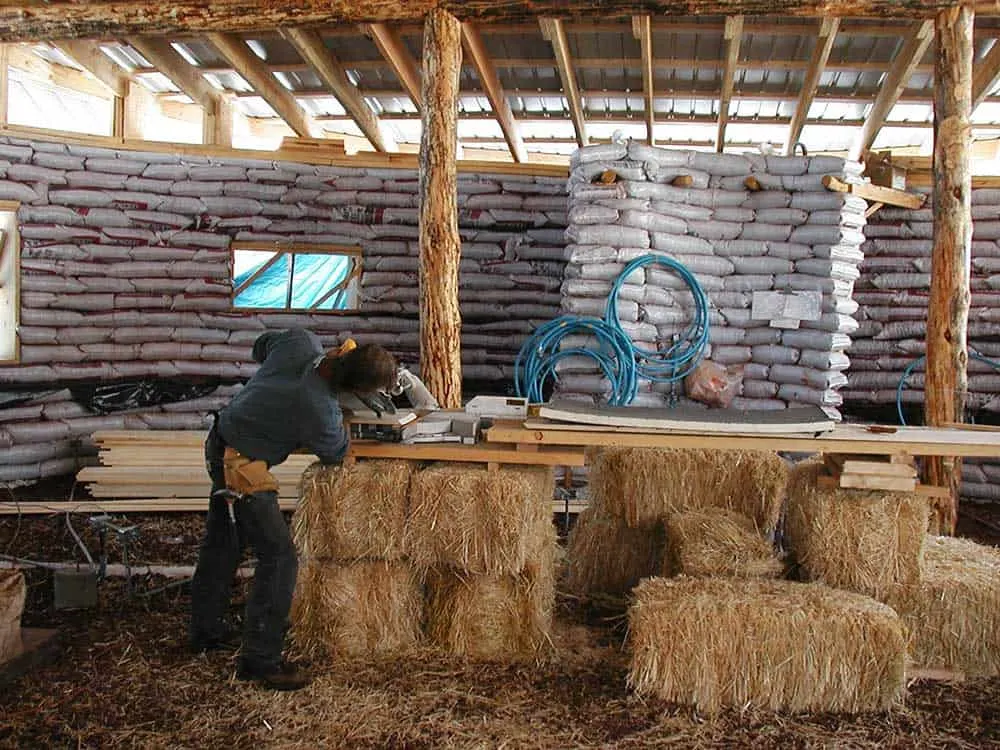
Why build with earthbags?
Cost – Earthbag construction is truly “dirt cheap”. Dirt to fill the bags is usually obtained right at the building site, eliminating the purchase and transportation costs of most traditional building materials.
In addition, earthbag houses use far fewer materials overall than traditional homes.
Another factor related to costs is energy savings. Earthbag houses provide natural insulation in the form of thermal mass, helping to keep the home cool in summer and warm in winter.
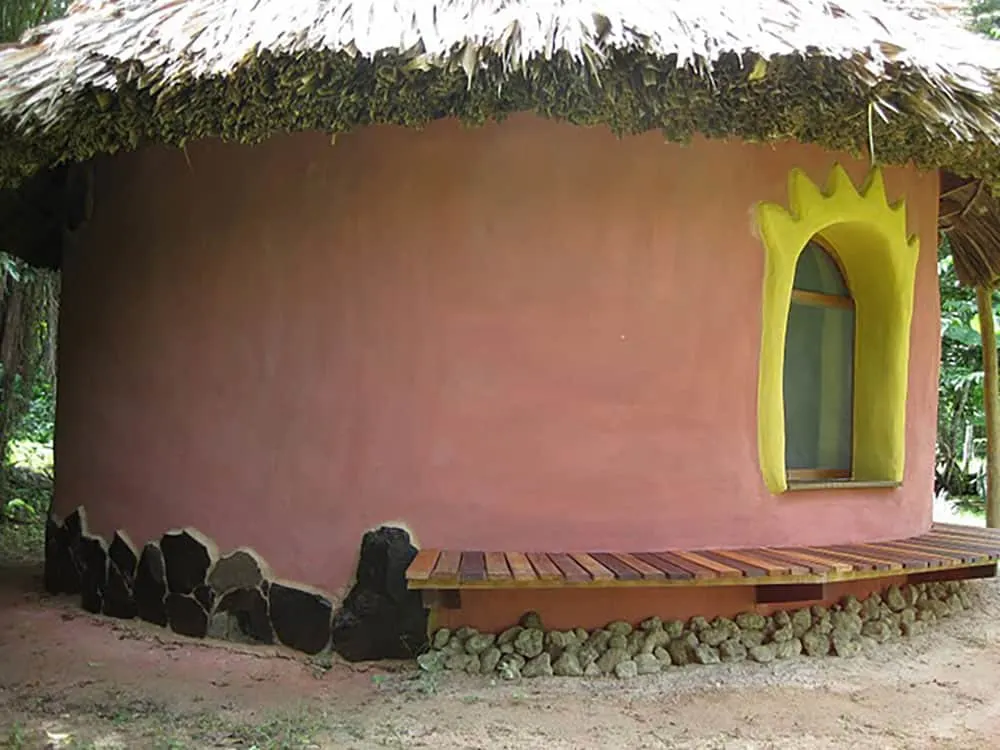
Garden shed in Belize via Earthbagbuilding.com
Simplicity – Compared to other building methods, earthbag construction requires skills and basic knowledge that can be learned by just about anyone and taught to others in a community.
Basic materials and tools can turn an idea and a pile of dirt into a beautiful structure.
Longevity & strength – For the most part, the components that make up dirt do not decompose. Therefore, a home built with dirt walls will outlast homes constructed from other materials.
The materials also make the home naturally fire-resistant and able to withstand extreme damp and dry climates equally well.
Earthbag buildings have even been shown to withstand earthquakes, and as such are being used around the world as emergency shelters and to rebuild homes in disaster-stricken areas.
There’s been at least one incident where a drunk driver hit an earthbag wall and only chipped the plaster. (The vehicle was totaled.) Earthbags also excel at withstanding floods, hurricanes, tornadoes and earthquakes. Engineered plans are now available for whatever conditions you face. Earthbags are even bullet resistant. -Owen Geiger of EarthbagBuilding.com
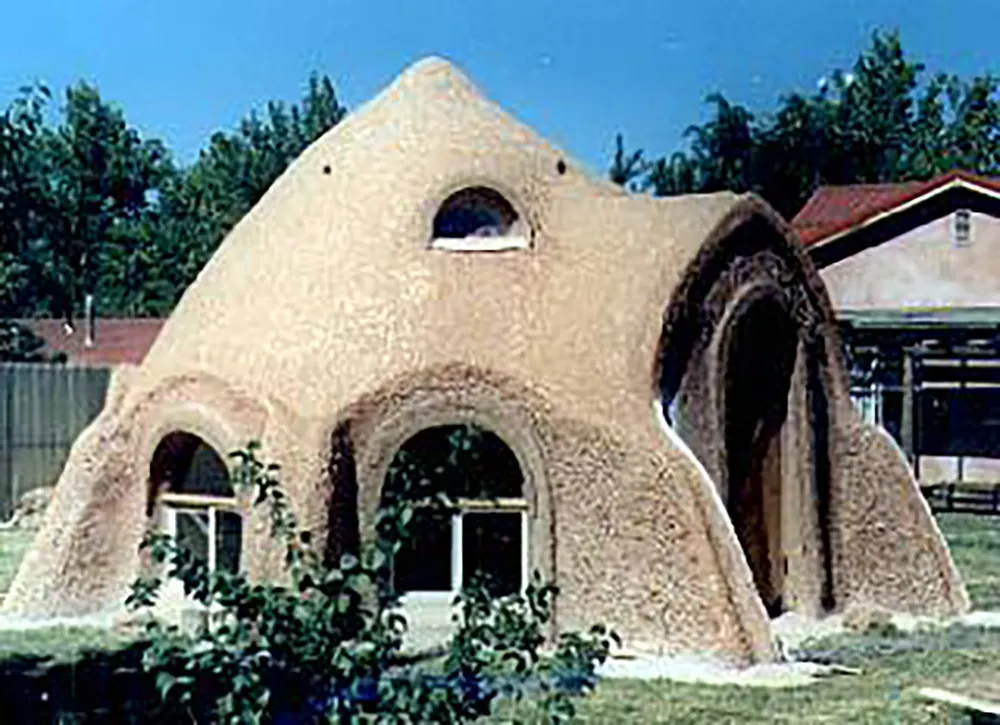
Image via Earthbag Building
Basic tips for building with earthbags
Owen Geiger of EarthbagBuilding.com wrote two incredible posts on Instructables explaining the step-by-step basics of building with earthbags. Following are some of his tips:
- Use polypropylene bags (as opposed to burlap) to prevent erosion of the bags over time. These can be found cheap from a variety of sources, including buying imperfects or misprints directly from bag manufacturers.
- Use buckets to fill the bags, and use the same number of buckets of material in each bag to ensure uniform sizing.
- Once the bags are filled, stitch the ends or fold them over to keep the material securely inside.
- Place barbed wire between each layer of bags to provide tensile strength and to keep the bags from slipping.
- Tamp down each layer of bags to prevent settling and to ensure each layer is level.
- Add doors and windows as you move up, checking the level often.
How to build an earthbag house
Assuming you have the building site cleared and leveled, the first step in earthbag construction is to dig a trench where the foundation will be placed. Approximately 12 inches of gravel should be placed in the trench, upon which the first layer of bags will be laid end to end.
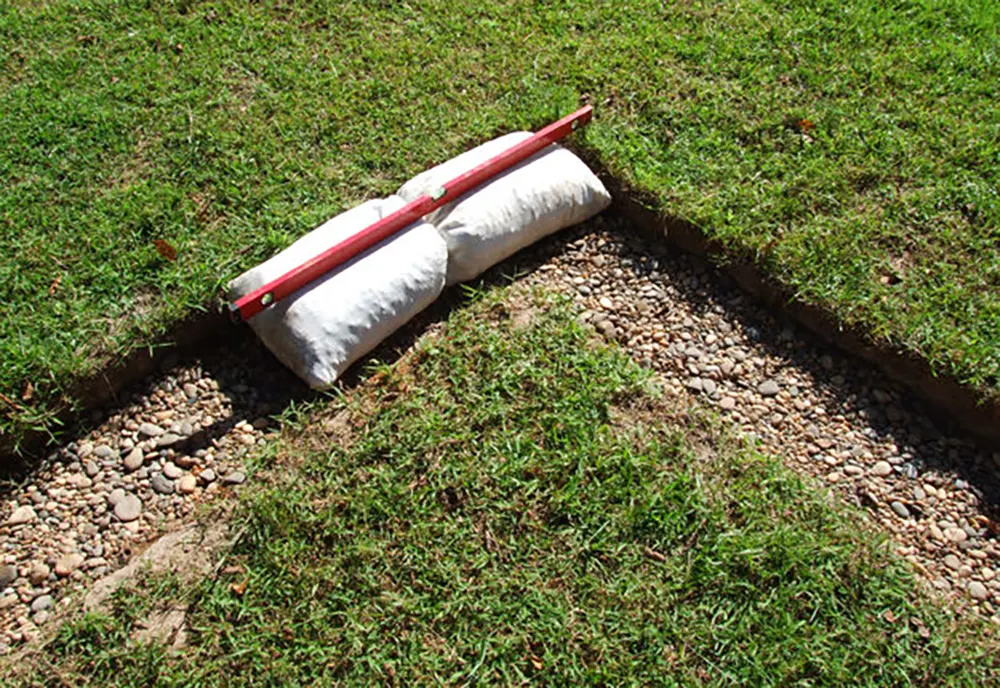
Owen Geiger | EarthbagBuilding.com
The bottom layers of bags should contain a heavier, aggregate material such as gravel. This provides stability in addition to the ability to drain water from the walls.
Subsequent layers consist of bags filled with soil. Two strands of barbed wire strung over each layer of bags are temporarily held in place with bricks.
Geiger uses a sheet metal slider when placing the bags to prevent them from snagging on the wire and ripping open.
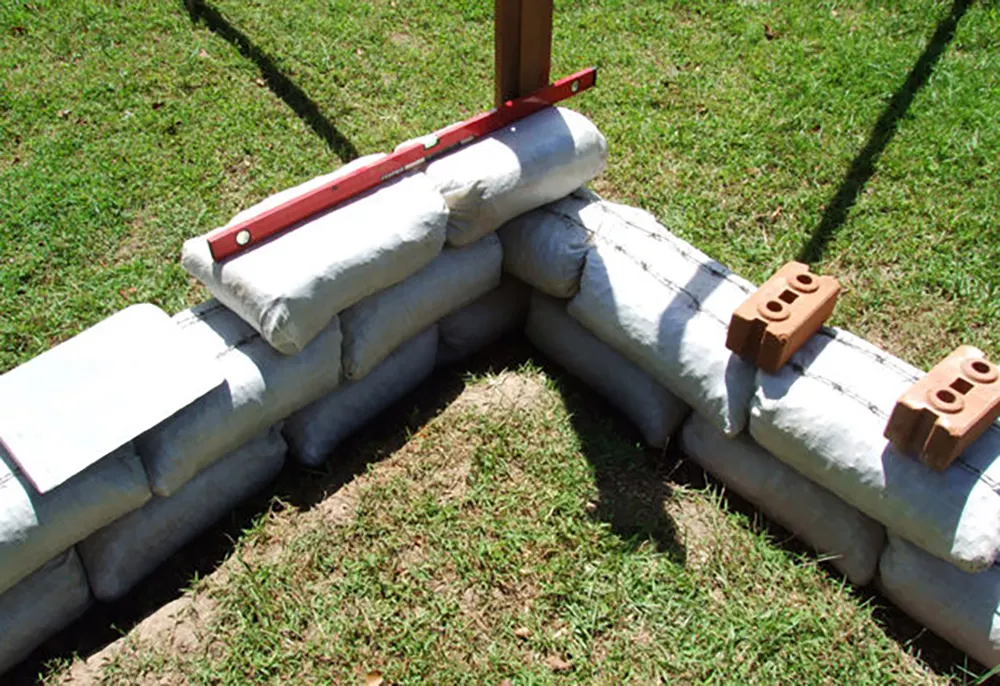
Owen Geiger | EarthbagBuilding.com
Building in the round is one of Geiger’s preferred methods of earthbag construction, as roundhouses are simple and incredibly strong.
To ensure a consistent shape, the foundation radius is measured from a center pole and each layer of bags is measured again to ensure accuracy.
Roundhouses are perhaps the simplest, fastest, easiest earthbag structure to build. We’re extremely pleased with the results, especially in terms of strength and cost. This is one of the strongest structures I’ve ever worked on in my 30-plus year construction career. The main impression is one of incredible fortresslike strength – massive walls with no sway.
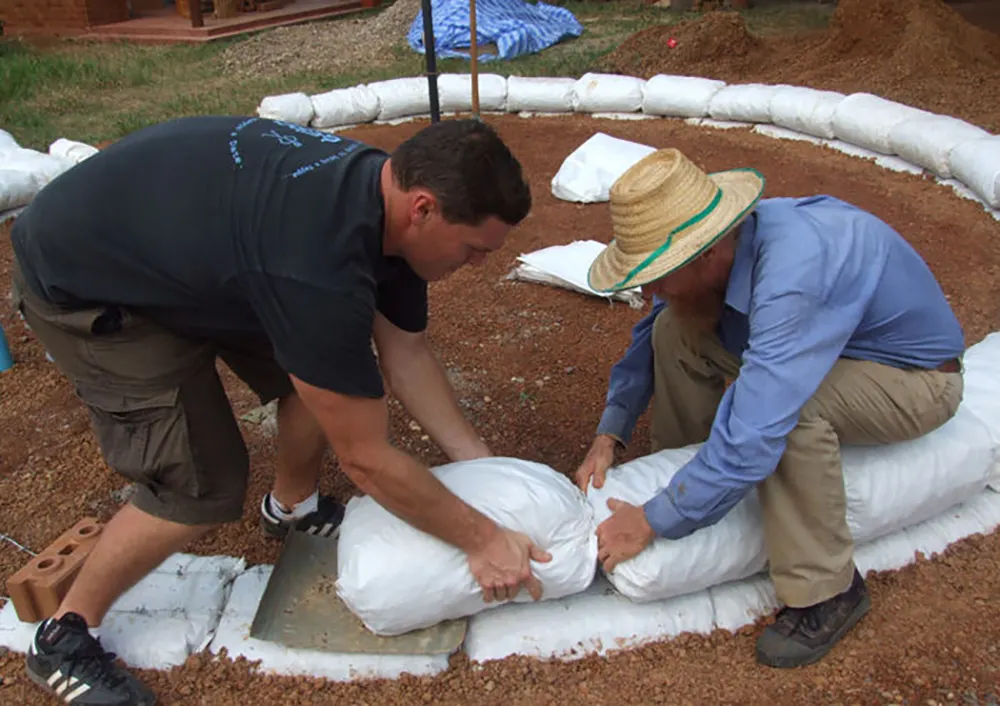
Owen Geiger | EarthbagBuilding.com
Durable thresholds made of concrete or stone are important to place in doorways, atop which a door frame is placed.
Metal or wood anchors are placed every few layers to secure door and window frames to the bags. Wood anchors are also placed within the layers of bags in places along the walls where electrical boxes will be attached
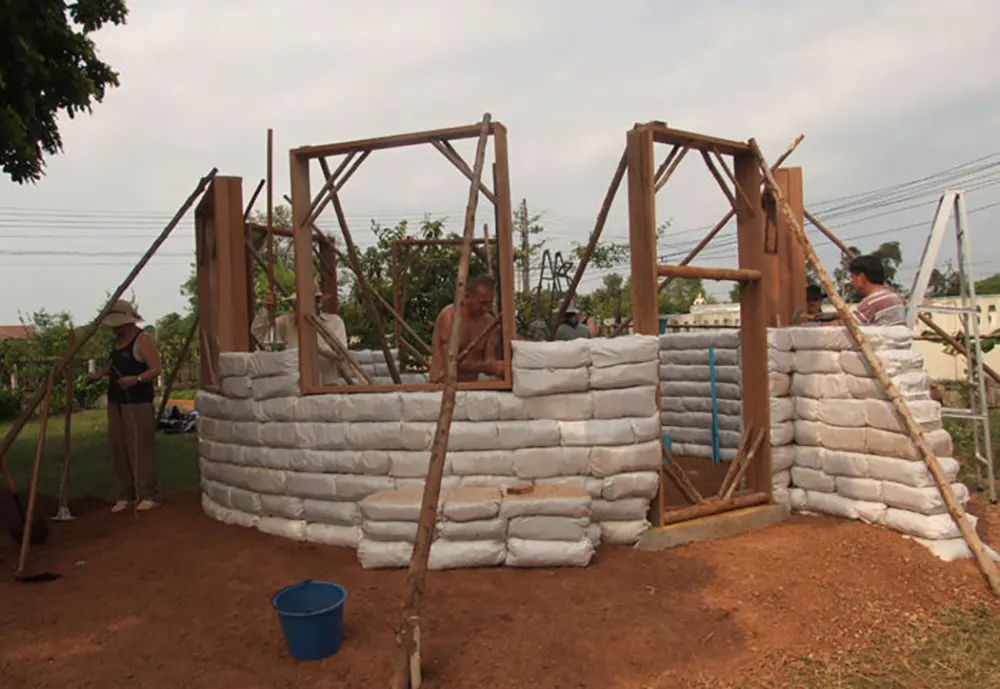
Owen Geiger | EarthbagBuilding.com
Once the bags are built up to a suitable height, the roof is constructed. In this case, the roof consists of a metal ring with radiating wood poles covered in thatch. In cold climates, thicker, insulated roofing material can be built instead of thatching.
The roundhouse has a super strong feeling due to the concrete bond beam, thick walls, sturdy poles and round shape. You could probably have a dozen workers on the roof with no visible effect.
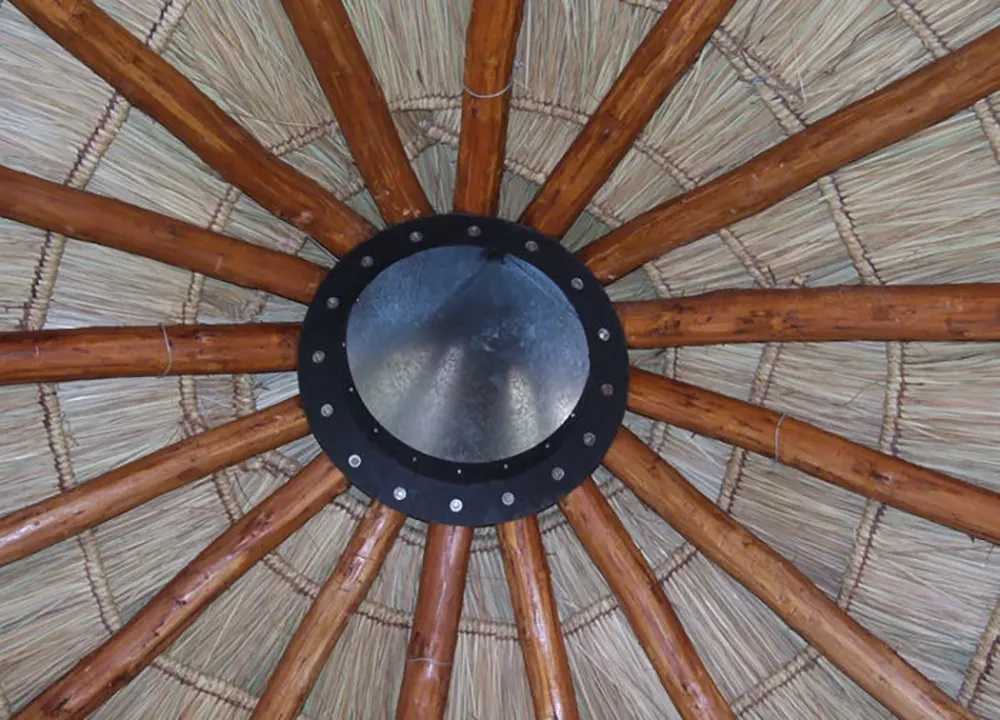
Owen Geiger | EarthbagBuilding.com
After the roofing is in place, doors and windows are added to their frames and the exterior of the building is covered in concrete. This concrete plaster is placed in layers, first in the wedges between each row of bags, then as subsequent layers until the exterior is smooth.
As you can see, the process is quite simple, although labor intensive. It boils down to adding a little plaster at a time. Leave each coat rough so the next coat will better adhere. No plaster mesh is needed – the plaster sticks to the earthbags, no problem.
The same concept applies to finishing the interior of the home. Earthen plaster creates gorgeous, smooth interior finishes. Viewing the interior of this home, it is hard to believe its walls consist of a pile of dirt bags, right?!

Owen Geiger | EarthbagBuilding.com
The last step to building an earthbag house is to install the electrical and plumbing fixtures, cabinets, shelves, etc. The finishing touches are what makes a house a home, and in this case, Geiger and his team did a fantastic job.
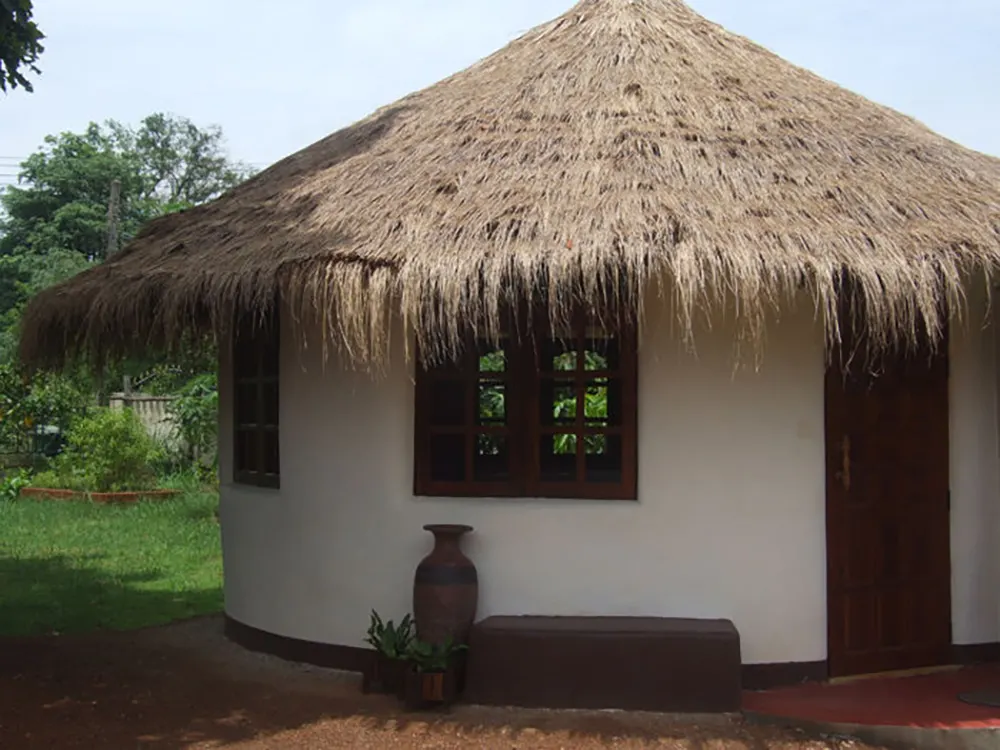
Owen Geiger | EarthbagBuilding.com
It boggles the mind how flimsy stick-built houses meet code and yet some people have doubts about earthbag building. (And even more hilarious is how trailer houses are somehow considered safe and adequate.) Let’s briefly compare stick frame and earthbag houses: A strong person could readily kick their way through pressed board siding and sheetrock in about one or two minutes. The same person would probably be struggling an hour later trying to penetrate an earthbag wall, even with a sledge hammer, pick, shovel and crow bar.
Read more detailed steps about this home build and about earthbag construction in general on Owen Geiger’s Instructables tutorials:
Step-by-Step Earthbag Building
and How to Build an Earthbag Roundhouse
You can also find a wealth of information on his website: EarthbagBuilding.com
